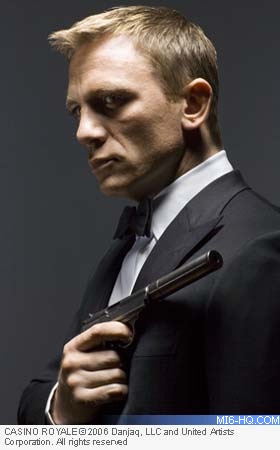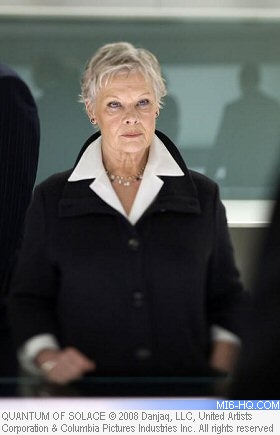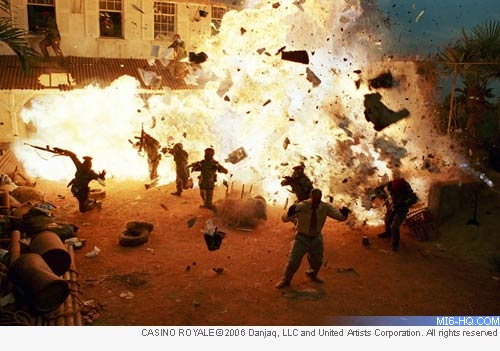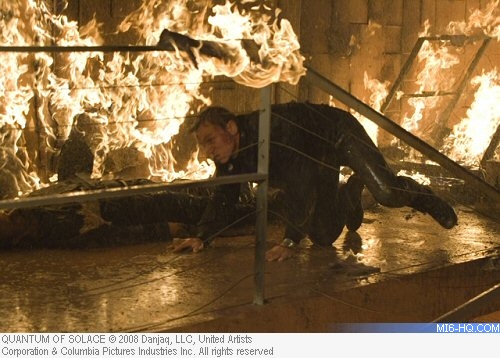 |
| |
James Bond and M have left some viewers less than
impressed as 007 endures complaints with the
BBFC...
|
|
Bond Begets Violence, Bad Language
23rd June 2009
James Bond may succeed in thwarting villains on behalf of Her
Majesty, but The British Board of Film Classification has revealed
that concerned viewers often bring his adventures in to closer
scrutiny than even M's watchful eye. Both of Daniel
Craig's outings
as James Bond have become interesting case studies at the
BBFC, as the shift in the series to more realistic action and
gritty
violence has the 12A certification brought in to question, and
the 'Dame Judi Dench' effect left some steaming about bad language.
|
"Casino
Royale" received the most complaints
for any film in 2006 according to the BBFC's annual reports,
whereas the level of feedback on "Quantum
of Solace" was
greatly reduced.
In their 2006 report, the BBFC noted that Casino Royale
sat on the borderline between 12A and 15 when first seen
in unfinished form, and they advised that the violence
would need to be toned down if the desired 12A category
was to be achieved. The versions submitted for formal classification
were, indeed, toned down and were in their view appropriately
placed at the upper end of 12A.
Casino Royale was the most complained about film with
82 complaints in 2006 and they were still coming in at
the beginning of 2007 [MI6 note: the tally currently stands
at 110 complaints]. The majority were about the level of
violence in the film, commenting that it should have been
a ‘15’. The BBFC notes that a couple of letters
complained about the level of nudity in the film, which
is surprising given that the love scenes were chaste by
comparison with other Bond films.
The opening black and white fight sequence and the torture
scene had pushed at the ‘12A’ boundary and in
fact the torture scene had been reduced in intensity after
an advice viewing. |
|

Above: Daniel Craig in Casino Royale.
The film racked up the most complaints in 2006.
|
The Panel felt that the film was a departure
from what the public had come to expect from
Bond films and as such the violence would come as
a surprise. It was felt by some members that the use
of black and white in the opening sequence intensified
the impact of the violence. The torture
scene was still considered very strong despite being
reduced. It was agreed that the death of Vesper
Lynd could be distressing for young children.
The Panel also discussed the fact that the ‘12A’ rating
covered material suitable for children in the 12 to 14 age group
and
that the
focus sometimes was on the reaction of very young children
rather than this age group. The problem with any
Bond film was that the public did see them as
family entertainment and it was inevitable that
a proportion of the audience would be well under
the age of 12. The majority view
was that
the film was appropriate for 12 to
14 year olds, but that parents taking young children
might be surprised by the gap between their expectations
and the film’s contents.
|

Above: The 'Dame Judi Dench factor'
created complaints when M uttered the line: "It'd
be a pretty cold bastard who didn't want revenge for
the death of someone he loved"
|
|
In contrast to the response to the BBFC's
classification of Casino Royale in 2006, the follow-up
Bond film, "Quantum
of Solace", also rated ‘12A’, generated
only six complaints. Only one of these was concerned with
the
film’s violence. Two mistook the shadow on a woman’s
thigh as a fleeting glimpse of her genitalia.
The remainder
were upset by the film’s language. This may be attributed
to the ‘Judi Dench factor’. This beloved actress
plays M, Bond’s tough-talking boss. However, it was
her tough talking which upset the viewers. Even though ‘bastard’ is
comfortably placed at ‘12A’,
it seems that she should not use such language. Almost every time Dame Judi swears
in a film, regardless of its category, we can expect a number of complaints,
the BBFC said in its 2008 year-end report. Contrary to popular belief, the 12A certificate was not
introduced for the film Spider-Man, but instead The Bourne
Identity. However, Spider-Man and other films still on
general release at the time were reclassified as 12A. Die
Another Day (2002) was the first Bond film to be classified
12A.
Casino Royale and Quantum of Solace were both given 12 certificates
for home release on DVD and Blu-Ray. |
Casino Royale Classification
Casino Royale was issued a 12A certification for exhibition in UK cinemas,
with the consumer advice statement that the film "contains one scene of torture
and strong action violence". The film was originally seen by the BBFC
in an unfinished version, for advice as to the film's suitability at '12A'.
The BBFC advised the company that the torture scene placed too much emphasis
on both the infliction of pain and the sadism of the villain for the requested
'12A' category. When the completed version of the film was submitted for classification,
reductions to the torture sequence had been made, including the removal of
lingering shots of the rope, close shots of Bond's facial reaction and the
substitution of a more distant shot of the beating compared to the original
version. This re-edited version of the scene was considered acceptable at '12A',
where the Guidelines permit violence provided there is no dwelling on detail
or emphasis on injuries.

Above: There goes the Embassy,
here come the complaints...
|
Quantum of Solace Classification
"Quantum of Solace" received a 12A its classification
for exhibition in UK cinemas, and a similar PG-13 in the USA.
The 22nd James Bond film "passed with no cuts made",
but as is usual for major motion pictures these days, an early
cut was viewed by the BBFC to advise the production on how to
secure the rating. The BBFC
"advised the company that the film would most likely receive
a '12A' as it was, but that care should be taken when finishing
the film not to increase the intensity of certain scenes. When
the completed version of the film was submitted for classification,
reductions to one of those scenes had been made and the film
was passed '12A' without cuts."
The film was classified ‘12A’ for frequent moderate
action violence. The film contains frequent, fast and furious action
sequences including high speed car chases and plane dogfights
with plenty
of gun fire and explosions. In most cases, there are few human
casualties visible in these scenes and where people are hurt
there is little or no focus on blood or wound detail. There are
some hand to hand fight sequences which include rapid, flurried
blows and some crunchy sound effects but with the detail of impacts
hidden by people’s bodies or lost in the rapid editing.
One knife fight does end with some blood on a man’s neck
and hands but as outlined in the BBFC Guidelines at ‘12A’,
the scene does not ‘dwell on detail’, there is ‘no
emphasis on injuries’ and there is no focus on blood. Similarly,
in one scene an axe is embedded in a man’s foot but all
detail is hidden by the man’s shoe and there is no sight
of blood or the injury.

Above: Viewers had perhaps learned
what to expect with the updated franchise when
"Quantum of Solace" was released, as complaints fell drastically.
|
The film also contains one scene of mild sexual threat as a
character, already established as an evil man, stands threateningly
over a clothed woman lying on a bed. There is also some mild
language, including uses of ‘bastard’, some mild
sex references, including people talking about ‘having
sex’ with or having ‘slept with’ other characters
and a scene in which a bare chested man lies back on a bed with
a woman whose bare back is exposed. There is also brief sight
of a still photo of a drowned man’s green tinged face with
some small but bloodless wounds.
Related Articles
 Casino
Royale
Casino
Royale
 Quantum
Of Solace
Quantum
Of Solace